Effect of In Situ Large Soil Column Translocation on CO2 and CH4 Fluxes under Two Temperate Forests of Northeastern China
Abstract
1. Introduction
2. Materials and Methods
2.1. Site Description and Collection of Soil Columns
2.2. Setup of the In Situ Large Soil Column Translocation Experiments
2.3. Data Calculation and Statistical Analysis
3. Results
3.1. Changes in Air Temperature and Soil Temperature at 5 cm Depth under MF and BF Stands
3.2. Effects of Soil Column Translocation on Soil CO2 and CH4 Fluxes under MF and BF Stands
3.3. Effects of Soil Temperature and Moisture on Soil CO2 and CH4 Fluxes
3.4. Effects of Warming and Cooling on Cumulative Soil CO2 and CH4 Fluxes in Temperate Forests
4. Discussion
4.1. Effects of Warming and Cooling on Soil CO2 Emissions under Temperate Forest Stands
4.2. Effects of Warming and Cooling on Soil CH4 Flux under Temperate Forest Stands
5. Conclusions and Future Perspectives
Author Contributions
Funding
Data Availability Statement
Conflicts of Interest
References
- IPCC. The Physical Science Basis. In Contribution of Working Group I to the Sixth Assessment Report of the Intergovernmental Panel on Climate Change; Cambridge University Press: Cambridge, UK, 2021. [Google Scholar]
- Lu, M.; Zhou, X.H.; Yang, Q.; Li, H.; Luo, Y.Q.; Fang, C.M.; Chen, J.K.; Yang, X.; Li, B. Responses of ecosystem carbon cycle to experimental warming: A meta-analysis. Ecology 2013, 94, 726–738. [Google Scholar] [PubMed]
- Melillo, J.M.; Frey, S.D.; DeAngelis, K.M.; Werner, W.J.; Bernard, M.J.; Bowles, F.P.; Pold, G.; Knorr, M.A.; Grandy, A.S. Long-term pattern and magnitude of soil carbon feedback to the climate system in a warming world. Science 2017, 358, 101–104. [Google Scholar] [PubMed]
- Bond-Lamberty, B.; Bailey, V.L.; Chen, M.; Gough, C.M.; Vargas, R. Globally rising soil heterotrophic respiration over recent decades. Nature 2018, 560, 80–83. [Google Scholar] [PubMed]
- Yan, W.M.; Zhong, Y.; Yang, J.Y.; Shangguan, Z.P.; Torn, M.S. Response of soil greenhouse gas fluxes to warming: A global meta-analysis of field studies. Geoderma 2022, 419, 115865. [Google Scholar]
- Law, B.E.; Ryan, M.G.; Anthoni, P.M. Seasonal and annual respiration of a ponderosa pine ecosystem. Glob. Chang. Biol. 1999, 5, 169–182. [Google Scholar]
- Bolstad, P.V.; Davis, K.J.; Martin, J.; Cook, B.D.; Wang, W. Component and whole-system respiration fluxes in northern deciduous forests. Tree Physiol. 2004, 24, 493–504. [Google Scholar]
- Ni, X.Y.; Groffman, P.M. Declines in methane uptake in forest soils. Proc. Natl. Acad. Sci. USA 2018, 115, 8587–8590. [Google Scholar]
- Yu, L.J.; Huang, Y.; Zhang, W.; Li, T.T.; Sun, W.J. Methane uptake in global forest and grassland soils from 1981 to 2010. Sci. Total Environ. 2017, 607, 1163–1172. [Google Scholar]
- Romero-Olivares, A.L.; Allison, S.D.; Treseder, K.K. Soil microbes and their response to experimental warming over time: A meta-analysis of field studies. Soil Biol. Biochem. 2017, 107, 32–40. [Google Scholar]
- Xu, X.K.; Duan, C.T.; Wu, H.H.; Luo, X.B.; Han, L. Effects of changes in throughfall on soil GHG fluxes under a mature temperate forest, northeastern China. J. Environ. Manag. 2021, 294, 112950. [Google Scholar]
- Xu, X.K. Effect of freeze-thaw disturbance on soil C and N dynamics and GHG fluxes of East Asia forests: Review and future perspectives. Soil Sci. Plant Nutr. 2022, 68, 15–26. [Google Scholar] [CrossRef]
- Wang, X.; Hu, H.B.; Zheng, X.; Deng, W.B.; Chen, J.Y.; Zhang, S.; Cheng, C. Will climate warming of terrestrial ecosystem contribute to increase soil greenhouse gas fluxes in plot experiment? A global meta-analysis. Sci. Total Environ. 2022, 827, 154114. [Google Scholar] [PubMed]
- Xu, X.K. Effect of changes in throughfall on soil respiration in global forest ecosystems: A meta-analysis. Forests 2023, 14, 1037. [Google Scholar] [CrossRef]
- Martins, C.S.C.; Nazaries, L.; Delgado-Baquerizo, M.; Macdonald, C.A.; Anderson, I.C.; Hobbie, S.E.; Venterea, R.T.; Reich, P.B.; Singh, B.K. Identifying environmental drivers of greenhouse gas emissions under warming and reduced rainfall in borealtemperate forests. Funct. Ecol. 2017, 31, 2356–2368. [Google Scholar] [CrossRef]
- Heinzle, J.; Kitzler, B.; Zechmeister-Boltenstern, S.; Tian, Y.; Kengdo, S.K.; Wanek, W.; Borken, W.; Schindlbacher, A. Soil CH4 and N2O response diminishes during decadal soil warming in a temperate mountain forest. Agri. For. Meteorol. 2023, 329, 109287. [Google Scholar] [CrossRef]
- Rustad, L.E.; Fernandez, I.J. Experimental soil warming effects on CO2 and CH4 flux from a low elevation spruce-fir forest soil in Maine, USA. Glob. Chang. Biol. 1998, 4, 597–605. [Google Scholar] [CrossRef]
- McHale, P.J.; Mitchell, M.J.; Bowles, F.P. Soil warming in a northern hardwood forest: Trace gas fluxes and leaf litter decomposition. Can. J. For. Res. 1998, 28, 1365–1372. [Google Scholar] [CrossRef]
- Hart, S.C. Potential impacts of climate change on nitrogen transformations and greenhouse gas fluxes in forests: A soil transfer study. Glob. Chang. Biol. 2006, 12, 1032–1046. [Google Scholar] [CrossRef]
- Melillo, J.M.; Butler, S.; Johnson, J.; Mohan, J.; Steudler, P.; Lux, H.; Burrows, E.; Bowles, F.; Smith, R.; Scott, L.; et al. Soil warming, carbon-nitrogen interactions, and forest carbon budgets. Proc. Natl. Acad. Sci. USA 2011, 108, 9508–9512. [Google Scholar] [CrossRef]
- Wang, H.; Liu, S.R.; Wang, J.X.; Li, D.J.; Shi, Z.M.; Liu, Y.C.; Xu, J.; Hong, P.Z.; Yu, H.L.; Zhao, Z.; et al. Contrasting responses of heterotrophic and root dependent respiration to soil warming in a subtropical plantation. Agric. For. Meteorol. 2017, 247, 221–228. [Google Scholar] [CrossRef]
- Karbin, S.; Hagedorn, F.; Dawes, M.A.; Niklaus, P.A. Treeline soil warming does not affect soil methane fluxes and the spatial micro-distribution of methanotrophic bacteria. Soil Biol. Biochem. 2015, 86, 164–171. [Google Scholar] [CrossRef]
- Liu, S.; Zheng, Y.; Ma, R.; Yu, K.; Han, Z.; Xiao, S.; Li, Z.; Wu, S.; Li, S.; Wang, J. Increased soil release of greenhouse gases shrinks terrestrial carbon uptake enhancement under warming. Glob. Chang. Biol. 2020, 26, 4601–4613. [Google Scholar] [CrossRef]
- Zimmermann, M.; Meir, P.; Bird, M.I.; Malhi, Y.; Ccahuana, A.J.Q. Climate dependence of heterotrophic soil respiration from a soil-translocation experiment along a 3000 m tropical forest altitudinal gradient. Eur. J. Soil Sci. 2009, 60, 895–906. [Google Scholar] [CrossRef]
- Li, F.; Yang, G.B.; Peng, Y.F.; Wang, G.Q.; Qin, S.Q.; Song, Y.T.; Fang, K.; Wang, J.; Yu, J.C.; Liu, L.; et al. Warming effects on methane fluxes differ between two alpine grasslands with contrasting soil water status. Agri. For. Meteorol. 2020, 290, 107988. [Google Scholar] [CrossRef]
- Wu, H.H.; Xu, X.K.; Cheng, W.G.; Han, L. Dissolved organic matter and inorganic N jointly regulate greenhouse gases fluxes from forest soils with different moistures during a freeze-thaw period. Soil Sci. Plant Nutr. 2020, 66, 163–176. [Google Scholar] [CrossRef]
- Wang, P.Y.; Wang, J.S.; Elberling, B.; Yang, L.; Chen, W.N.; Song, L.; Yan, Y.J.; Wang, S.; Pan, J.X.; He, Y.L.; et al. Increased annual methane uptake driven by warmer winters in an alpine meadow. Glob. Chang. Biol. 2022, 28, 3246–3259. [Google Scholar] [CrossRef]
- Rey, M.; Guntiñas, E.; Gil-Sotres, F.; Leirós, M.C.; Trasar-Cepeda, C. Translocation of soils to stimulate climate change: CO2 emissions and modifications to soil organic matter. Eur. J. Soil Sci. 2007, 58, 1233–1243. [Google Scholar] [CrossRef]
- Luan, J.W.; Liu, S.R.; Chang, S.X.; Wang, J.X.; Zhu, X.L.; Liu, K.; Wu, J.H. Different effects of warming and cooling on the decomposition of soil organic matter in warm-temperate oak forests: A reciprocal translocation experiment. Biogeochemistry 2014, 121, 551–564. [Google Scholar] [CrossRef]
- Nottingham, A.T.; Whitaker, J.; Ostle, N.J.; Bardgett, R.D.; McNamara, N.P.; Fierer, N.; Salinas, N.; Ccahuana, A.J.Q.; Turner, B.L.; Meir, P. Microbial responses to warming enhance soil carbon loss following translcoation across a typical forest elevation gradient. Ecol. Lett. 2019, 22, 1889–1899. [Google Scholar] [CrossRef]
- Zhao, D.S.; Zheng, D.; Wu, S.H.; Wu, Z.F. Climate changes in northeastern China during last four decades. Chin. Geogr. Sci. 2007, 17, 317–324. [Google Scholar] [CrossRef]
- Zhang, J.B.; Sun, B.; Zhu, J.J.; Wang, J.K.; Pan, X.C.; Gao, T. Black soil protection and utilization based on harmonization of mountain-rive-forest-farmland-lake-grassland-sandy land ecosystems and strategic construction of ecological barrier. Bull. Chin. Acad. Sci. 2021, 36, 1155–1164. [Google Scholar]
- Zhou, G.; Liu, Q.J.; Xu, Z.Z.; Du, W.X.; Yu, J.; Meng, S.W.; Zhou, H.; Qi, L.H.; Shah, S. How can the shade intolerant Korean pine survive under dense deciduous canopy? For. Ecol. Manag. 2020, 457, 117735. [Google Scholar] [CrossRef]
- Wu, H.H.; Xu, X.K.; Duan, C.T.; Li, T.S.; Cheng, W.G. Synergistic effects of dissolved organic carbon and inorganic nitrogen on methane uptake in forest soils without and with freezing treatment. Sci. Rep. 2016, 6, 32555. [Google Scholar] [CrossRef][Green Version]
- Wu, H.H.; Xu, X.K.; Cheng, W.G.; Fu, P.Q.; Li, F.Y. Antecedent soil moisture prior to freezing can affect quantity, composition and stability of soil dissolved organic matter during thaw. Sci. Rep. 2017, 7, 6380. [Google Scholar] [CrossRef] [PubMed]
- Hao, Z.Q.; Zhang, J.; Song, B.; Ye, J.; Li, B.H. Vertical structure and spatial associations of dominant tree species in an old-growth temperate forest. For. Ecol. Manag. 2007, 252, 1–11. [Google Scholar] [CrossRef]
- Xu, X.K.; Han, L.; Wang, Y.S.; Inubushi, K. Influence of vegetation types and soil properties on microbial biomass carbon and metabolic quotients in temperate volcanic and tropical forest soils. Soil Sci. Plant Nutr. 2007, 53, 430–440. [Google Scholar] [CrossRef]
- Xu, X.K.; Yin, L.; Duan, C.T.; Jing, Y.S. Effect of N addition, moisture, and temperate on soil microbial respiration and microbial biomass in forest soil at different stages of litter decomposition. J. Soils Sediments 2016, 16, 1421–1439. [Google Scholar] [CrossRef]
- Wang, N.; Wang, C.K.; Quan, X.K. Variations in fine root dynamics and turnover rates in five forest types in northeastern China. J. For. Res. 2020, 31, 871–884. [Google Scholar] [CrossRef]
- Mariko, S.; Nishimura, N.; Mo, W.H.; Matsui, Y.; Kibe, T.; Koizumi, H. Winter CO2 flux from soil and snow surfaces in a cool-temperate deciduous forest, Japan. Ecol. Res. 2000, 15, 363–372. [Google Scholar] [CrossRef]
- Mo, W.H.; Lee, M.S.; Uchida, M.; Inatomi, M.; Saigusa, N.; Mariko, S.; Koizumi, H. Seasonal and annual variations in soil respiration in a cool-temperate deciduous broad-leaved forest in Japan. Agri. For. Meteorol. 2005, 134, 81–94. [Google Scholar] [CrossRef]
- Wang, C.K.; Han, Y.; Chen, J.Q.; Wang, X.C.; Zhang, Q.Z.; Bond-Lamberty, B. Seasonality of soil CO2 efflux in a temperate forest: Biophysical effects of snowpack and spring freeze–thaw cycles. Agri. For. Meteorol. 2013, 77, 83–92. [Google Scholar] [CrossRef]
- Hicks, L.C.; Meir, P.; Nottingham, A.T.; Reay, D.S.; Stott, A.W.; Salinas, N.; Whitaker, J. Carbon and nitrogen inputs differently affect priming of soil organic matter in tropical lowland and montane soils. Soil Biol. Biochem. 2019, 129, 212–222. [Google Scholar] [CrossRef]
- van Straaten, O.; Veldkamp, E.; Kohler, M.; Anas, I. Spatial and temporal effects of drought on soil CO2 efflux in a cacao agroforestry system in Sulawesi, Indonesia. Biogeosciences 2010, 7, 1223–1235. [Google Scholar] [CrossRef]
- Suseela, V.; Dukes, J.S. The responses of soil and rhizosphere respiration to simulated climatic changes vary by season. Ecology 2013, 94, 403–413. [Google Scholar] [CrossRef] [PubMed]
- Zhang, X.; Zhang, Y.P.; Sha, L.Q.; Wu, C.S.; Tan, Z.H.; Song, Q.H.; Liu, Y.T.; Dong, L.Y. Effects of continuous drought stress on soil respiration in a tropical rainforest in southwest China. Plant Soil 2015, 394, 343–353. [Google Scholar] [CrossRef]
- Bréchet, L.M.; Lopez-Sangil, L.; George, C.; Birkett, A.J.; Baxendale, C.; Trujillo, B.C.; Sayer, E.J. Distinct responses of soil respiration to experimental litter manipulation in temperate woodland and tropical forest. Ecol. Evol. 2018, 8, 3787–3796. [Google Scholar] [CrossRef]
- Liu, L.; Estiarte, M.; Penuelas, J. Soil moisture as the key factor of atmospheric CH4 uptake in forest soils under environmental change. Geoderma 2019, 355, 113920. [Google Scholar] [CrossRef]
- Dijkstra, F.A.; Morgan, J.A.; von Fischer, J.C.; Follett, R.F. Elevated CO2 and warming effects on CH4 uptake in a semiarid grassland below optimum soil moisture. J. Geophy. Res. 2011, 116, G01007. [Google Scholar]
- Kupka, D.; Pan, K.W.; Gruba, P. Initial responses of soil chemical properties to simulated warming in Norway spruce (Picea abies (L.) H.Karst.) stands in the Western Carpathians. Geoderma 2023, 432, 116400. [Google Scholar]
- Li, Y.Q.; Qing, Y.X.; Lyu, M.K.; Chen, S.D.; Yang, Z.J.; Lin, C.F.; Yang, Y.S. Effects of artificial warming on different soil organic carbon and nitrogen pools in a subtropical plantation. Soil Biol. Biochem. 2018, 124, 161–167. [Google Scholar] [CrossRef]
- Wu, H.H.; Xu, X.K.; Fu, P.Q.; Cheng, W.G.; Fu, C.S. Responses of soil WEOM quantity and quality to freeze-thaw and litter manipulation with contrasting soil water content: A laboratory experiment. Catena 2021, 198, 105058. [Google Scholar] [CrossRef]
- Tang, S.R.; Cheng, W.G.; Hu, R.G.; Guigue, J.; Hattori, S.; Tawaraya, K.; Tokida, T.; Fukuoka, M.; Yoshimoto, M.; Sakai, H.; et al. Five-year soil warming changes soil C and N dynamics in a single rice paddy field in Japan. Sci. Total Environ. 2021, 756, 143845. [Google Scholar] [CrossRef] [PubMed]
- Li, C.N.; Tu, B.; Kou, Y.P.; Wang, Y.S.; Li, X.Z.; Wang, J.M.; Li, J.B. The assembly of methanotrophic communities regulated by soil pH in a mountain ecosystem. Catena 2020, 196, 104883. [Google Scholar] [CrossRef]
- Xu, X.; Inubushi, K. Responses of ethylene and methane consumption to temperature and pH in temperate volcanic forest soils. Eur. J. Soil Sci. 2009, 60, 489–498. [Google Scholar] [CrossRef]
- Del Grosso, S.J.; Parton, W.J.; Mosier, A.R.; Ijima, D.S.; Potter, C.S.; Borken, W.; Brunmme, R.; Butterbach-Bahl, K.; Crill, P.M.; Dobbie, K.; et al. General CH4 oxidation model and comparisons of CH4 oxidation in natural and managed systems. Glob. Biogeochem. Cy. 2000, 14, 999–1019. [Google Scholar] [CrossRef]
- Zhou, Y.M.; Hagedorn, F.; Zhou, C.L.; Jiang, X.J.; Wang, X.X.; Li, M.H. Experimental warming of a mountain tundra increases soil CO2 effluxes and enhances CH4 and N2O uptake at Changbai Mountain, China. Sci. Rep. 2016, 6, 21108. [Google Scholar] [CrossRef]
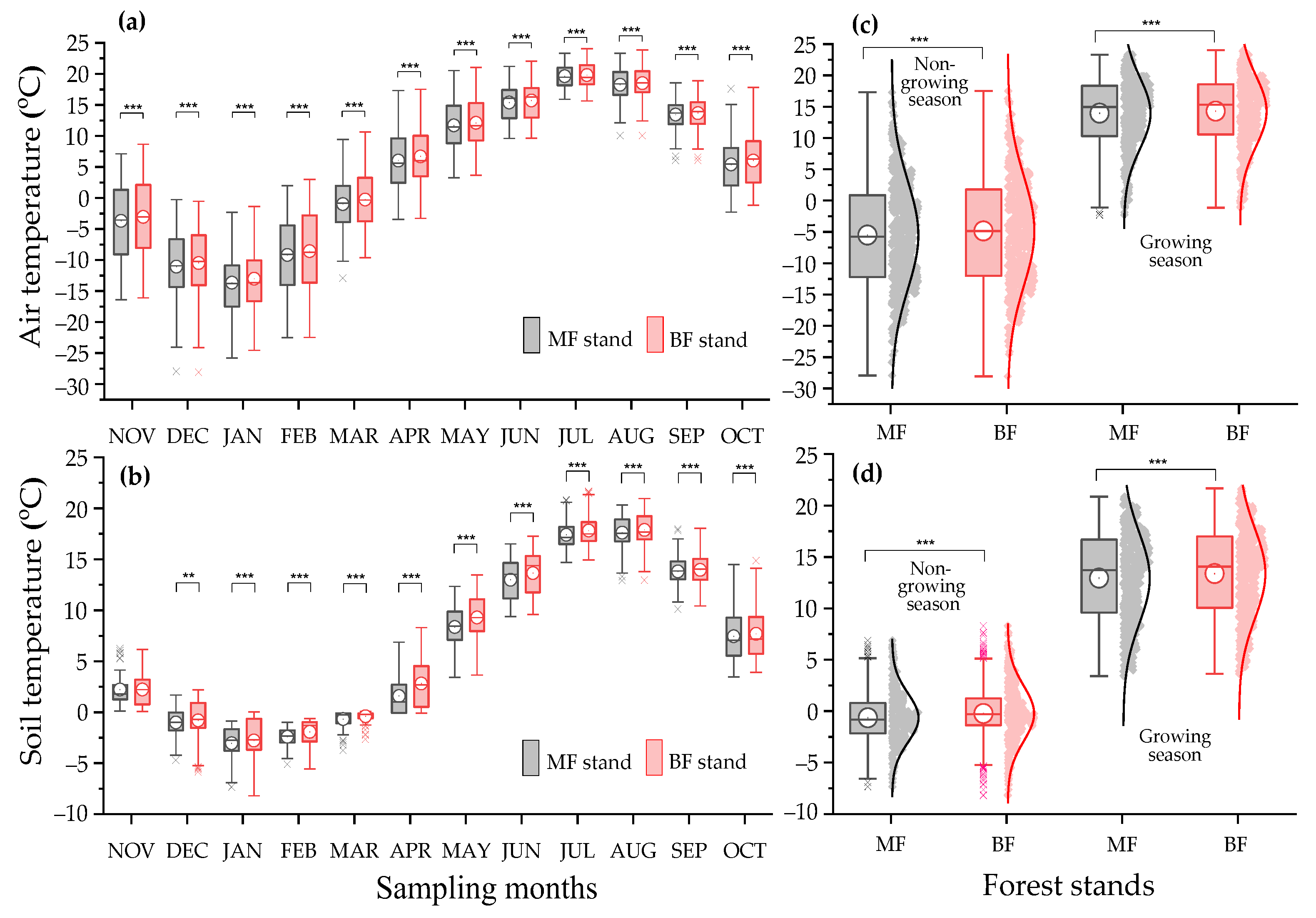
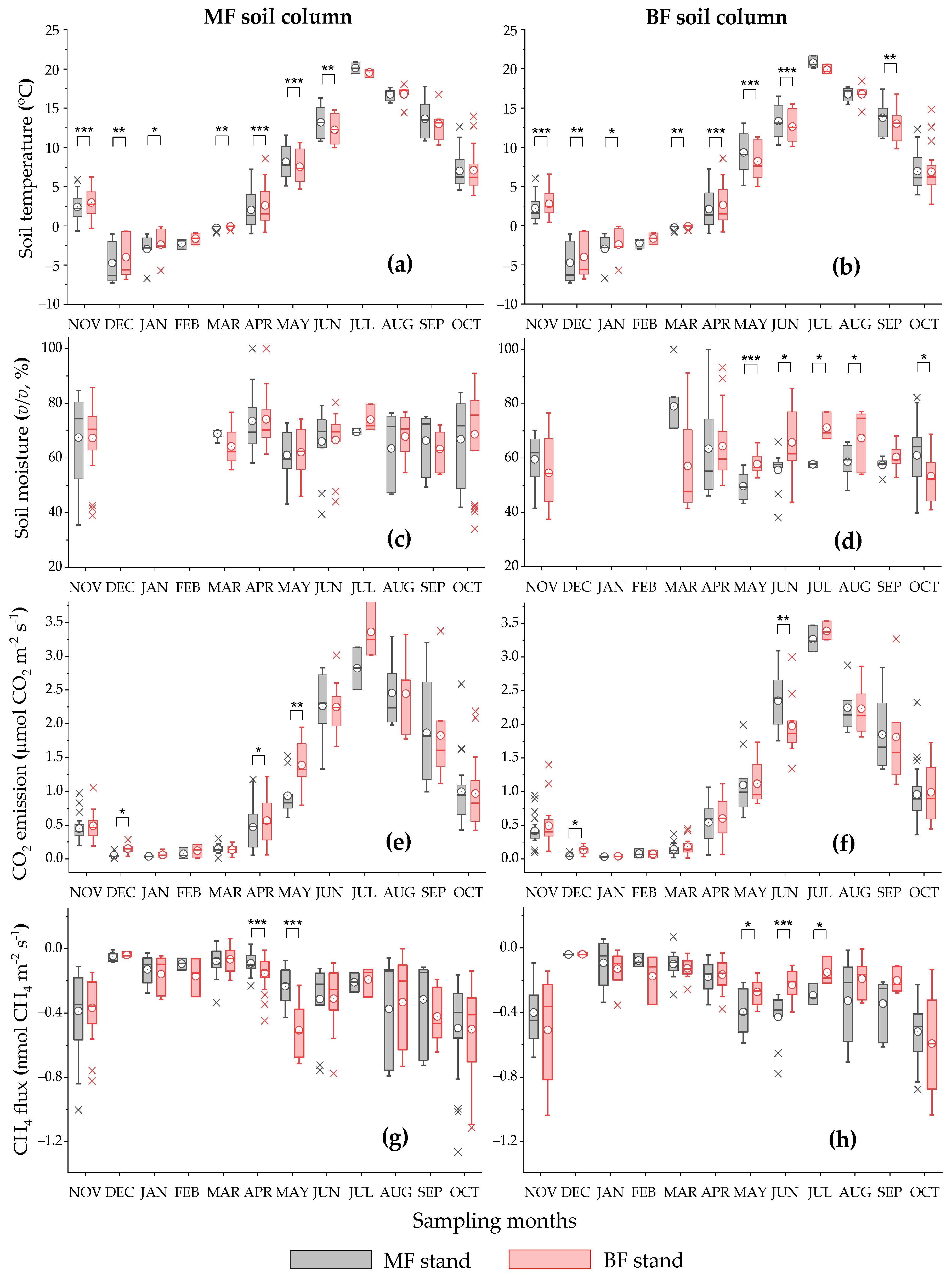

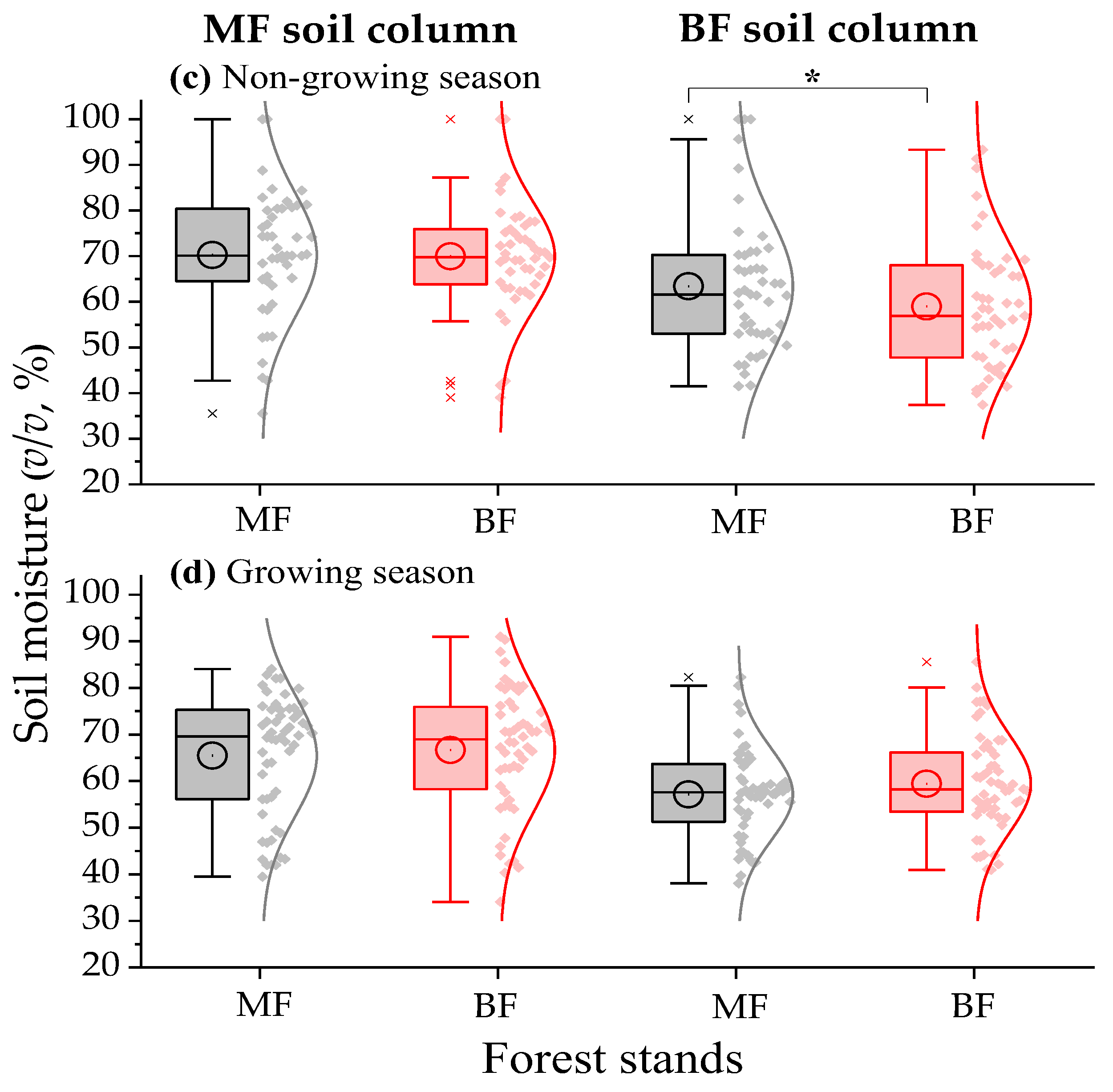


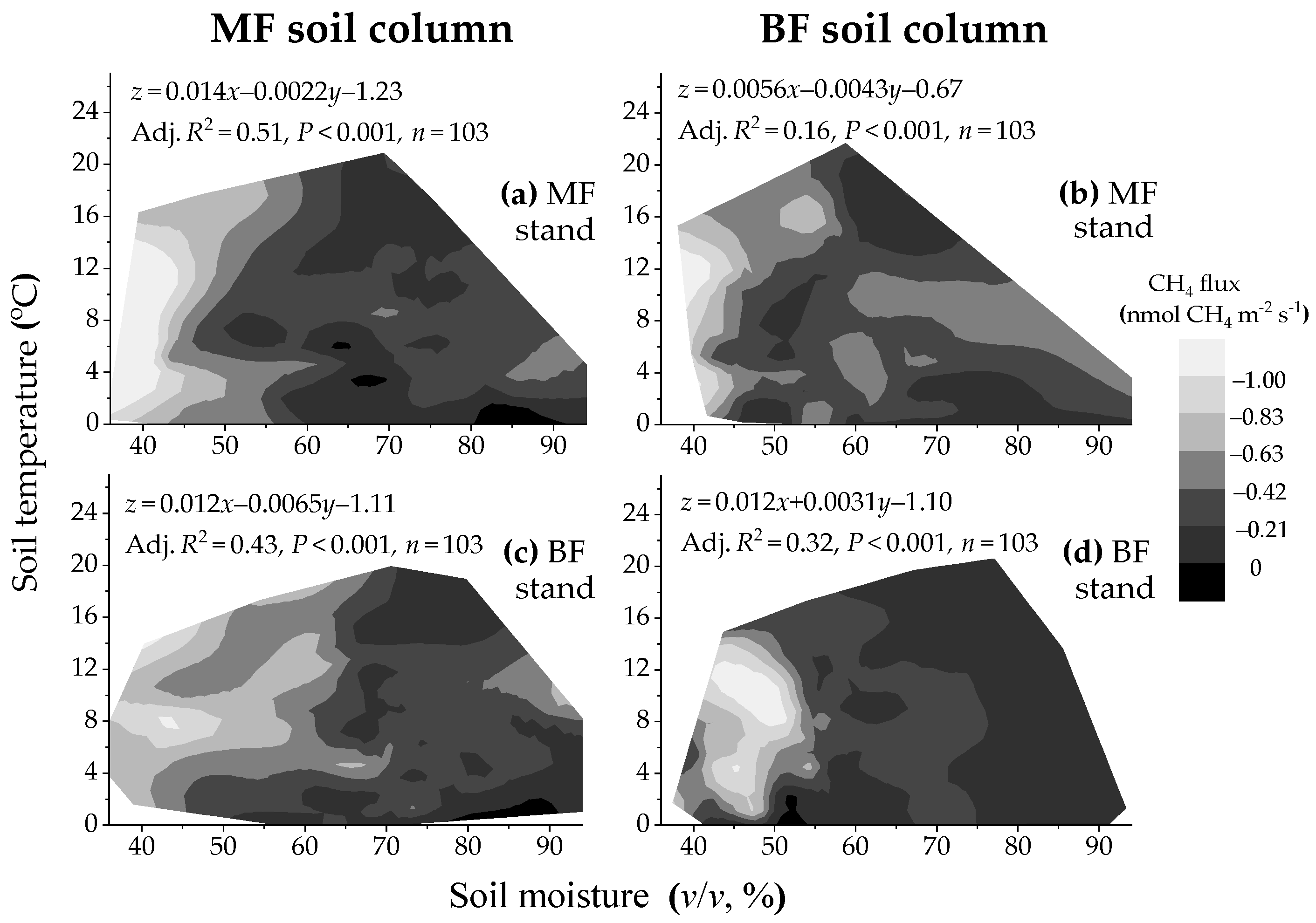
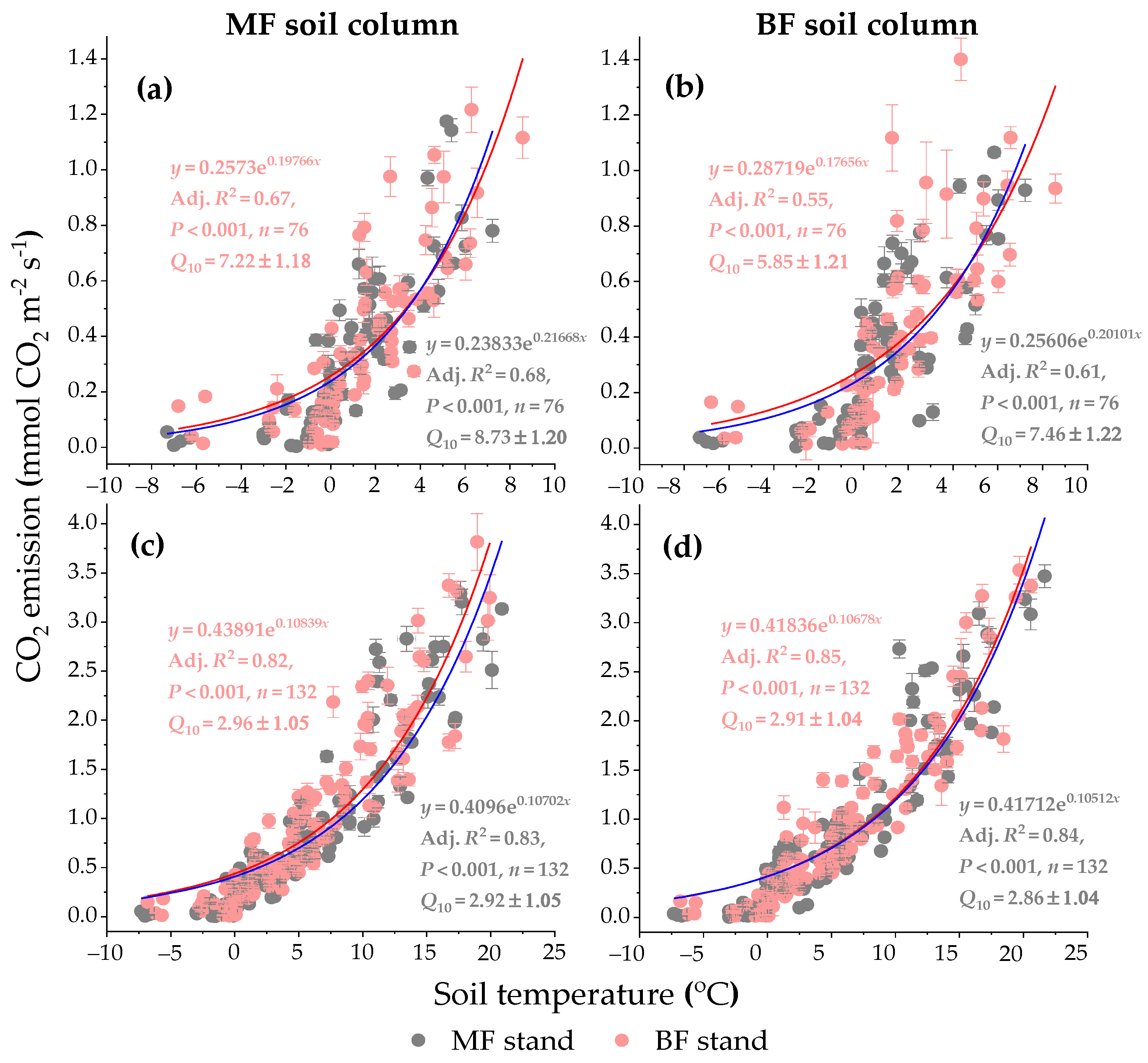

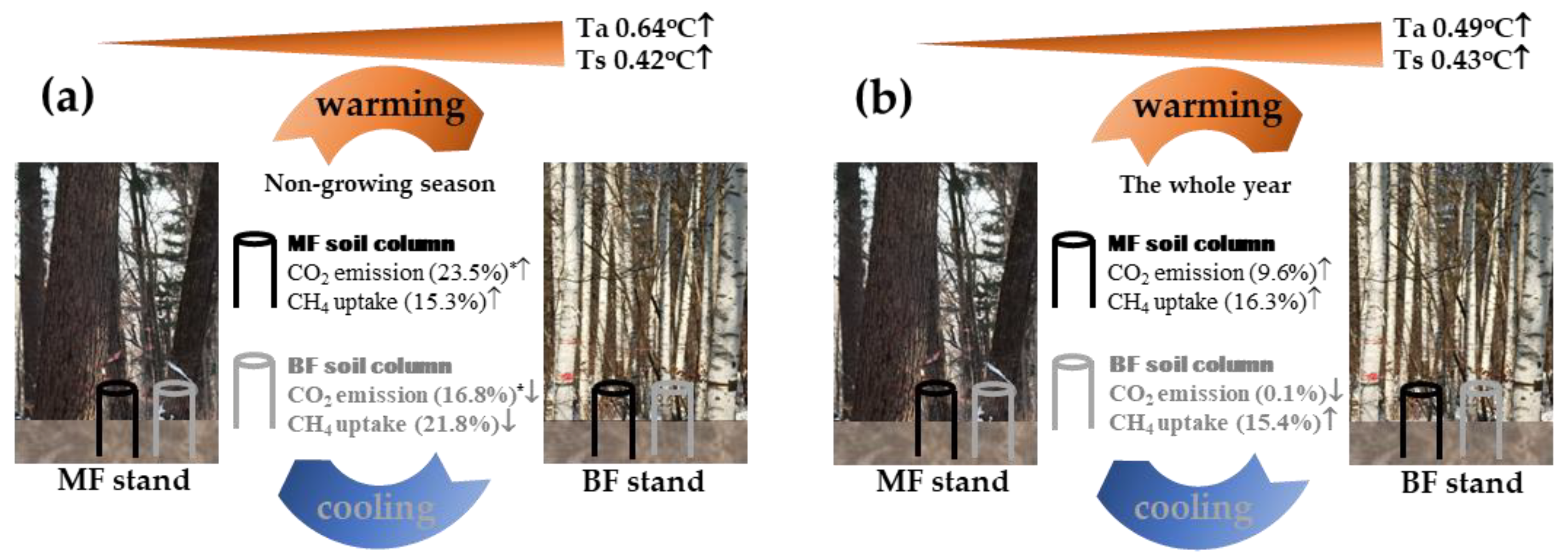
Disclaimer/Publisher’s Note: The statements, opinions and data contained in all publications are solely those of the individual author(s) and contributor(s) and not of MDPI and/or the editor(s). MDPI and/or the editor(s) disclaim responsibility for any injury to people or property resulting from any ideas, methods, instructions or products referred to in the content. |
© 2023 by the authors. Licensee MDPI, Basel, Switzerland. This article is an open access article distributed under the terms and conditions of the Creative Commons Attribution (CC BY) license (https://creativecommons.org/licenses/by/4.0/).
Share and Cite
Xu, X.; Xu, T.; Yue, J. Effect of In Situ Large Soil Column Translocation on CO2 and CH4 Fluxes under Two Temperate Forests of Northeastern China. Forests 2023, 14, 1531. https://doi.org/10.3390/f14081531
Xu X, Xu T, Yue J. Effect of In Situ Large Soil Column Translocation on CO2 and CH4 Fluxes under Two Temperate Forests of Northeastern China. Forests. 2023; 14(8):1531. https://doi.org/10.3390/f14081531
Chicago/Turabian StyleXu, Xingkai, Tingting Xu, and Jin Yue. 2023. "Effect of In Situ Large Soil Column Translocation on CO2 and CH4 Fluxes under Two Temperate Forests of Northeastern China" Forests 14, no. 8: 1531. https://doi.org/10.3390/f14081531
APA StyleXu, X., Xu, T., & Yue, J. (2023). Effect of In Situ Large Soil Column Translocation on CO2 and CH4 Fluxes under Two Temperate Forests of Northeastern China. Forests, 14(8), 1531. https://doi.org/10.3390/f14081531






